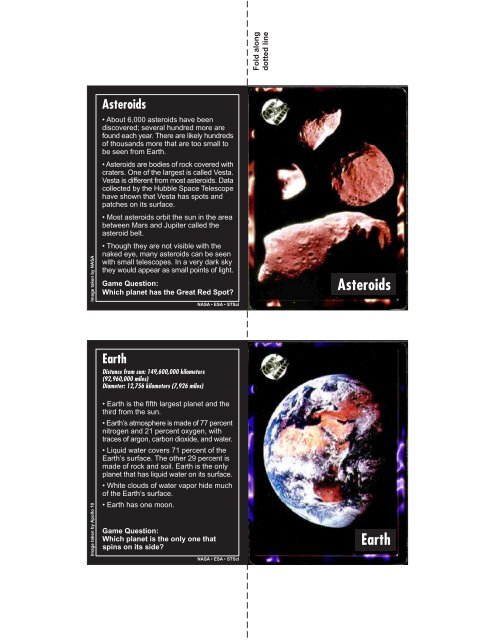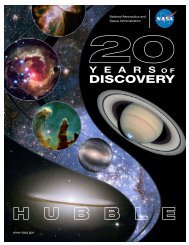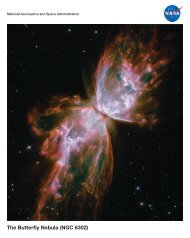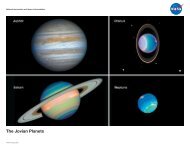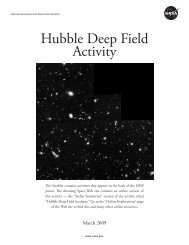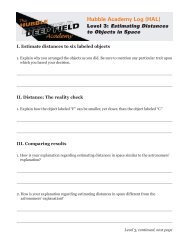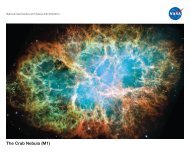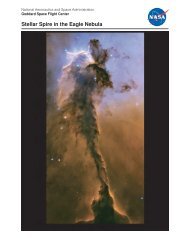PDF of Solar System Trading Cards - Amazing Space - STScI
PDF of Solar System Trading Cards - Amazing Space - STScI
PDF of Solar System Trading Cards - Amazing Space - STScI
- No tags were found...
Create successful ePaper yourself
Turn your PDF publications into a flip-book with our unique Google optimized e-Paper software.
Fold alongdotted lineImage taken by NASAAsteroids• About 6,000 asteroids have beendiscovered; several hundred more arefound each year. There are likely hundreds<strong>of</strong> thousands more that are too small tobe seen from Earth.• Asteroids are bodies <strong>of</strong> rock covered withcraters. One <strong>of</strong> the largest is called Vesta.Vesta is different from most asteroids. Datacollected by the Hubble <strong>Space</strong> Telescopehave shown that Vesta has spots andpatches on its surface.• Most asteroids orbit the sun in the areabetween Mars and Jupiter called theasteroid belt.• Though they are not visible with thenaked eye, many asteroids can be seenwith small telescopes. In a very dark skythey would appear as small points <strong>of</strong> light.Game Question:Which planet has the Great Red Spot?NASA • ESA • <strong>STScI</strong>AsteroidsEarthDistance from sun: 149,600,000 kilometers(92,960,000 miles)Diameter: 12,756 kilometers (7,926 miles)Image taken by Apollo 10• Earth is the fifth largest planet and thethird from the sun.• Earth’s atmosphere is made <strong>of</strong> 77 percentnitrogen and 21 percent oxygen, withtraces <strong>of</strong> argon, carbon dioxide, and water.• Liquid water covers 71 percent <strong>of</strong> theEarth’s surface. The other 29 percent ismade <strong>of</strong> rock and soil. Earth is the onlyplanet that has liquid water on its surface.• White clouds <strong>of</strong> water vapor hide much<strong>of</strong> the Earth’s surface.• Earth has one moon.Game Question:Which planet is the only one thatspins on its side?NASA • ESA • <strong>STScI</strong>Earth
Image taken by the Hubble <strong>Space</strong> TelescopeFold alongdotted lineMarsDistance from sun: 227,940,000 kilometers (141,600,000miles) ; Diameter: 6,794 kilometers (4,222 miles)• Mars’ surface has craters, valleys, ridges,hills, and plateaus.• A long time ago, Mars’ surface had liquidwater, too. The planet has clear evidence<strong>of</strong> erosion in many places. Now, all thewater left on Mars is frozen in the polarice caps.• Mars has a very thin atmosphere thatcontains mostly carbon dioxide.• Mars’ surface is red; its clouds and hazeare blue. Mars is the seventh largest planetand the fourth from the sun. The planet isabout 11/2 times as far from the sun asthe Earth. Its diameter is about one-half<strong>of</strong> the Earth’s diameter.• Mars has two known moons.Game Question:Which planet is sometimes fartherfrom the sun than Pluto?NASA • ESA • <strong>STScI</strong>MarsImage taken by the Hubble <strong>Space</strong> TelescopeComets• Comets are a mixture <strong>of</strong> ice and dustthat failed to come together to form aplanet. They are sometimes called “dirtysnowballs” or “icy mudballs.”• Comets are almost invisible, exceptwhen they are near the sun’s heat.• Comets become visible when ice ischanged into gas by the sun’s heat. Thegas carries dust. This dust and gas formthe comet’s head and tail.• Some famous comets are Halley,Hyakutake, and Shoemaker-Levy 9.• Meteor showers sometimes occur whenthe Earth passes through a comet’s orbit.Game Question:Which planet is sometimes calledEarth’s sister planet?NASA • ESA • <strong>STScI</strong>
Image taken by Mariner 10Fold alongdotted lineMercuryDistance from sun: 58,344,000 kilometers(36,250,000 miles)Diameter: 4,880 kilometers (3,032 miles)• Mercury is, in many ways, similar to theEarth’s moon because its solid surface iscovered with craters.• There is evidence <strong>of</strong> ice in the protectedshadows <strong>of</strong> craters near the north pole.• Mercury has almost no atmosphere.• Mercury is the eighth largest planet andthe closest to the sun. Mercury is about onethird<strong>of</strong> the Earth’s distance from the sun.Mercury’s diameter is about one-third <strong>of</strong> theEarth’s diameter.• Mercury has phases, like the moon. Mercurylooks like a crescent moon when it passesbetween Earth and the sun. Mercury has nomoons.Game Question:Which is the only planet that has liquidwater on its surface?NASA • ESA • <strong>STScI</strong>MercuryImage taken by the Hubble <strong>Space</strong> TelescopeJupiterDistance from sun: 778,330,000 kilometers (483,600,000miles) ; Diameter: 142,984 kilometers (88,850 miles)• Jupiter is the fifth planet from the sun andabout five times as far from the sun as theEarth. Its diameter is about 11 times greaterthan the Earth’s diameter.• More than 1,000 Earths could fit inside Jupiter.• Jupiter does not have a solid surface. Theplanet is a ball <strong>of</strong> liquid surrounded by gas.• By mass, Jupiter is made <strong>of</strong> 75 percenthydrogen and 23 percent helium, with traces<strong>of</strong> methane, water, ammonia, and rock.• Jupiter has an interesting feature called theGreat Red Spot, a huge storm <strong>of</strong> swirling gasthat has lasted for hundreds and hundreds<strong>of</strong> years. But the Great Red Spot may notappear bright red.• Jupiter has 16 known moons, four large and12 small.Game Question:Which object is the largest in the solar system?NASA • ESA • <strong>STScI</strong>Jupiter
Image taken by the Hubble <strong>Space</strong> TelescopeFold alongdotted linePlutoDistance from sun: 5,913,520,000 kilometers(3,674,000,000 miles)Diameter: 2,340 kilometers (1,454 miles)• Pluto is the smallest planet and usually thefarthest from the sun. Pluto is about 40 timesas far from the sun as the Earth. Its diameteris about one-fifth <strong>of</strong> the Earth’s diameter.• Pluto is the only planet that has not beenvisited by a spacecraft. Only recently has theHubble <strong>Space</strong> Telescope seen features onPluto’s surface. The images <strong>of</strong> Pluto are notclear because the planet is so far away.• Pluto’s composition is unknown, but it isprobably mostly rock, ice, and frozen gases.• Pluto’s atmosphere is also unknown, but itmost likely contains mainly nitrogen, with alittle carbon monoxide and traces <strong>of</strong> methane.• Pluto has one known moon, Charon.Game Question:Which group <strong>of</strong> space objects is made<strong>of</strong> chunks <strong>of</strong> rock?NASA • ESA • <strong>STScI</strong>PlutoImage taken by the Hubble <strong>Space</strong> TelescopeNeptuneDistance from sun: 4,504,000,000 kilometers(2,798,655,850 miles)Diameter: 49,528 kilometers (30,775 miles)• Neptune is the fourth largest planet andthe eighth from the sun. Neptune is about30 times farther than the Earth is from thesun. Its diameter is about four times largerthan Earth’s diameter.• Neptune’s orbit is sometimes crossed byPluto’s irregular orbit. Since 1979 Neptunehas been the most distant planet from thesun; Pluto again will be the most distant in1999. Neptune’s atmosphere contains mostlyhydrogen and helium with a small amount<strong>of</strong> methane.• The small amount <strong>of</strong> methane givesNeptune its blue-green color. Neptune haseight known moons, the largest, Triton, isalmost as big as Earth’s moon.Game Question:Which celestial objects are called“dirty snowballs”?NASA • ESA • <strong>STScI</strong>Neptune
Image taken by the Hubble <strong>Space</strong> TelescopeFold alongdotted lineSaturnDistance from sun: 1,429,400,000 kilometers(888,200,000 miles)Diameter: 120,536 kilometers (74,900 miles)• Saturn is the second largest planet and thesixth from the sun. Saturn is about 10 timesas far from the sun as the Earth. Its diameteris about nine times larger than the Earth’sdiameter.• Saturn is made <strong>of</strong> materials that are lighterthan water. If you could fit Saturn in a bathtub,it would float!• By mass, Saturn contains about 92 percenthydrogen and 6 percent helium, with traces<strong>of</strong> methane, ammonia, water, and rock.• Saturn has thousands <strong>of</strong> rings. Saturn’srings are made <strong>of</strong> rocks, dust, and water ice,all <strong>of</strong> which are orbiting the planet.• Saturn has 18 named moons, the most <strong>of</strong>any planet.Game Question:Which planet is closest to the sun?NASA • ESA • <strong>STScI</strong>SaturnImage taken by Yohkoh SatelliteSunDiameter: 1,390,000 kilometers (863,710 miles)• The sun is the biggest, brightest, and hottestobject in the solar system.• The sun is an ordinary star, one <strong>of</strong> 100 billionor more stars in our galaxy.• More than 1 million Earths could fit insidethe sun. It is, by far, the largest object in thesolar system.• By mass, the sun is made <strong>of</strong> about 70 percenthydrogen and 28 percent helium.• The sun is about 4.5 billion years old. It willcontinue to put out heat and light for about 5billion more years.• Sunspots are cooler regions on the sun’ssurface. X-ray images <strong>of</strong> the sun, such as theone on the front <strong>of</strong> this card, show jets <strong>of</strong> fireon its surface. These fireballs are giant storms— called solar flares — on the sun’s surface.Game Question:Which planet, other than Earth, shows evidence<strong>of</strong> once having liquid water on its surface?NASA • ESA • <strong>STScI</strong>Sun
Fold alongdotted lineImage taken by the Hubble <strong>Space</strong> TelescopeUranusDistance from sun: 2,870,990,000 kilometers(1,784,000,000 miles )Diameter: 51,118 kilometers (31,760 miles)• Uranus is the third largest planet and theseventh from the sun. Uranus is about 19times as far from the sun as the Earth. Itsdiameter is about four times larger than theEarth’s diameter.• Uranus is one <strong>of</strong> the four giant gas planets.Like other giant gas planets, Uranus’ corewas made from rock pieces and frozen gas.• The atmosphere on Uranus contains, bymass, about 72 percent hydrogen, 26 percenthelium, and some methane.• The methane is what makes the planetappear blue-green.• Uranus spins on an axis that is tilted morethan any other planet. The planet looks likea top spinning on its side.• Uranus has 15 known moons.Game Question:Which planet is, by far, the smallest?NASA • ESA • <strong>STScI</strong>UranusImage taken by the Hubble <strong>Space</strong> TelescopeVenusDistance from sun: 108,200,000 kilometers (67,230,000miles) ; Diameter: 12,103 kilometers (7,521 miles)• Venus is the sixth largest planet and the secondfrom the sun. Venus is about three-fourths <strong>of</strong> theEarth’s distance from the sun.• The surface is rocky and very hot. Theatmosphere completely hides the surface andtraps the heat. The temperature is around 400degrees Celsius (780 degrees Fahrenheit).• The atmosphere contains mostly carbon dioxide.The layers <strong>of</strong> clouds surrounding Venus containsulfuric acid.• The image on the front <strong>of</strong> this card makes Venuslook purple. But the planet is really white andfeatureless.• Venus is sometimes regarded as Earth’s sisterplanet. The two objects are very similar in manyways. Venus is only slightly smaller than Earth.The two planets also are made from similar kinds<strong>of</strong> material, such as rock. Venus has no moons.Game Question:Which planet is famous for its rings?NASA • ESA • <strong>STScI</strong>Venus
Fold alongdotted lineCover: Hubble <strong>Space</strong> Telescope during First Servicing Mission / NASA imageHow to Play1.2.3.4.5.The teacher distributes one card to each<strong>of</strong> 12 students.The students silently read the informationon the back <strong>of</strong> their cards.The game begins when one studentreads aloud the information and thequestion on the back <strong>of</strong> his or her card.The student holding the card with theanswer to the question stands and readsthe information on his or her card.The game continues until all the cardshave been read.NASA • ESA • <strong>STScI</strong>HST


